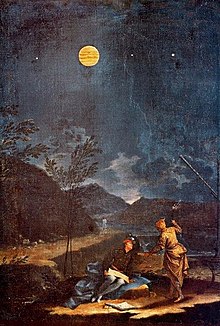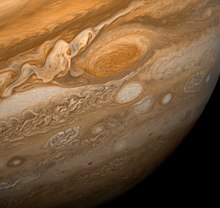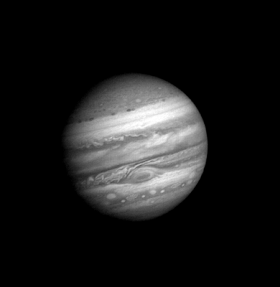Great Red Spot

The Great Red Spot is a persistent high-pressure region in the atmosphere of Jupiter, producing an anticyclonic storm that is the largest in the Solar System. It is the most recognizable feature on Jupiter, owing to its red-orange color whose origin is still unknown. Located 22 degrees south of Jupiter's equator, it produces wind-speeds up to 432 km/h (268 mph). Observations from 1665 to 1713 are believed to be of the same storm; if this is correct, it has existed for at least 359 years.[1] It was next observed in September 1831, with 60 recorded observations between then and 1878, when continuous observations began.[2][3]
Observation history
First observations


The Great Red Spot may have existed before 1665, but it could be that the present spot was first seen only in 1830, and was well studied only after a prominent appearance in 1879. The storm that was seen in the 17th century may have been different from the storm that exists today.[4] A long gap separates its period of current study after 1830 from its 17th century discovery. Whether the original spot dissipated and reformed, whether it faded, or if the observational record was simply poor is unknown.[5]
The first sighting of the Great Red Spot is often credited to
A minor mystery concerns a Jovian spot depicted in a 1711 canvas by Donato Creti, which is exhibited in the Vatican.[9][10] Part of a series of panels in which different (magnified) heavenly bodies serve as backdrops for various Italian scenes, and all overseen by the astronomer Eustachio Manfredi for accuracy, Creti's painting is the first known depiction of the Great Red Spot as red (albeit raised to the Jovian northern hemisphere due to an optical inversion inherent to the era's telescopes). No Jovian feature was explicitly described in writing as red before the late 19th century.[10]
The Great Red Spot has been observed since 5 September 1831. By 1879, over 60 observations had been recorded.[2] Since it came into prominence in 1879, it has been under continuous observation.
Late 20th and 21st centuries

On 25 February 1979,[11] when the Voyager 1 spacecraft was 9,200,000 km (5,700,000 mi) from Jupiter, it transmitted the first detailed image of the Great Red Spot. Cloud details as small as 160 km (100 mi) across were visible. The colorful, wavy cloud pattern seen to the left (west) of the Red Spot is a region of extraordinarily complex and variable wave motion.
In the 21st century, the major diameter of the Great Red Spot has been observed to be shrinking in size. At the start of 2004, its length was about half that of a century earlier, when it reached a size of 40,000 km (25,000 mi), about three times the diameter of Earth. At the present rate of reduction, it will become circular by 2040. It is not known how long the spot will last, or whether the change is a result of normal fluctuations.[12] In 2019, the Great Red Spot began "flaking" at its edge, with fragments of the storm breaking off and dissipating.[13] The shrinking and "flaking" fueled speculation from some astronomers that the Great Red Spot could dissipate within 20 years.[14] However, other astronomers believe that the apparent size of the Great Red Spot reflects its cloud coverage and not the size of the actual, underlying vortex, and they also believe that the flaking events can be explained by interactions with other cyclones or anticyclones, including incomplete absorptions of smaller systems; if this is the case, this would mean that the Great Red Spot is not in danger of dissipating.[15]
A smaller spot, designated
The Juno spacecraft, which entered into a polar orbit around Jupiter in 2016, flew over the Great Red Spot upon its close approach to Jupiter on 11 July 2017, taking several images of the storm from a distance of about 8,000 km (5,000 mi) above the surface.[20][21] Over the duration of the Juno mission, the spacecraft continued to study the composition and evolution of Jupiter's atmosphere, especially its Great Red Spot.[20]
The Great Red Spot should not be confused with the Great Dark Spot, a feature observed near the northern pole of Jupiter in 2000 with the Cassini–Huygens spacecraft.[22] There is also a feature in the atmosphere of Neptune called the Great Dark Spot. The latter feature was imaged by Voyager 2 in 1989 and may have been an atmospheric hole rather than a storm. It was no longer present as of 1994, although a similar spot had appeared farther to the north.
Mechanical dynamics

Jupiter's Great Red Spot rotates counterclockwise, with a period of about 4.5 Earth days,[23] or 11 Jovian days, as of 2008. Measuring 16,350 km (10,160 mi) in width as of 3 April 2017, the Great Red Spot is 1.3 times the diameter of Earth.[20] The cloud-tops of this storm are about 8 km (5 mi) above the surrounding cloud-tops.[24] The storm has continued to exist for centuries because there is no planetary surface (only a mantle of hydrogen) to provide friction; circulating gas eddies persist for a very long time in the atmosphere because there is nothing to oppose their angular momentum.[25]
Infrared data has long indicated that the Great Red Spot is colder (and thus higher in altitude) than most of the other clouds on the planet.[26] The upper atmosphere above the storm, however, has substantially higher temperatures than the rest of the planet. Acoustic (sound) waves rising from the turbulence of the storm below have been proposed as an explanation for the heating of this region.[27] The acoustic waves travel vertically up to a height of 800 km (500 mi) above the storm where they break in the upper atmosphere, converting wave energy into heat. This creates a region of upper atmosphere that is 1,600 K (1,330 °C; 2,420 °F)—several hundred kelvins warmer than the rest of the planet at this altitude.[27] The effect is described as like "crashing [...] ocean waves on a beach".[28]

Careful tracking of atmospheric features revealed the Great Red Spot's counterclockwise circulation as far back as 1966, observations dramatically confirmed by the first time-lapse movies from the Voyager fly-bys.[29] The spot is confined by a modest eastward jet stream to its south and a very strong westward one to its north.[30] Though winds around the edge of the spot peak at about 432 km/h (268 mph), currents inside it seem stagnant, with little inflow or outflow.[31] The rotation period of the spot has decreased with time, perhaps as a direct result of its steady reduction in size.[32]
The Great Red Spot's
Internal depth and structure
Galileo and Cassini's thermal infrared imaging and spectroscopy of the GRS were conducted during 1995–2008, in order to find evidence of thermal inhomogeneities within the internal structure vortex of the GRS.[40] Previous thermal infrared temperature maps from the Voyager, Galileo, and Cassini missions suggested the GRS is a structure of an anticyclonic vortex with a cold core within a upwelling warmer annulus; this data shows a gradient in the temperature of the GRS.[38][40] Better understanding of Jupiter's atmospheric temperature, aerosol particle opacity, and ammonia gas composition was provided by thermal-IR imaging: a direct correlation of the visible cloud layers reactions, thermal gradient and compositional mapping to observational data were collected over decades.[38][40] During December 2000, high spatial resolution images from Galileo, of an atmospheric turbulent area to the northwest of the GRS, showed a thermal contrast between the warmest region of the anticyclone and regions to the east and west of the GRS.[40][42]

The vertical temperature of the structure of the GRS is constrained between the 100–600 mbar range, with the vertical temperature of the GRS core is approximately 400 mbar of pressure[
The highest concentrations of PH3 and NH3 were found to the north of the GRS peripheral rotation. They aided in determining the southward jet movement and showed evidence of an increase in altitude of the column of aerosols with pressures ranging from 200–500 mbar.[40][46] However, the NH3 composition data shows that there is a major depletion of NH3 below the visible cloud layer at the southern peripheral ring of the GRS; this lower opacity is relative to a narrow band of atmospheric subsidence.[40] The low mid-IR aerosol opacity, along with the temperature gradients, the altitude difference, and the vertical movement of the zonal winds, are involved with the development and sustainability of the vorticity.[40] The stronger atmospheric subsidence and compositional asymmetries of the GRS suggest that the structure exhibits a degree of tilt from the northern edge to the southern edge of the structure.[40][47] The GRS depth and internal structure has been constantly changing over decades;[39] however there is still no logical reason that it is 200–500 km in depth, but the jet streams that supply the force that powers the GRS vortex are well below the structure base.[39][40]
Color and composition
It is not known what causes the Great Red Spot's reddish color. Hypotheses supported by laboratory experiments suppose that it may be caused by chemical products created from the solar ultraviolet irradiation of ammonium hydrosulfide[48] and the organic compound acetylene, which produces a reddish material—likely complex organic compounds called tholins.[49] The high altitude of the compounds may also contribute to the coloring.[50]
The Great Red Spot varies greatly in hue, from almost brick-red to pale salmon or even white. The spot occasionally disappears, becoming evident only through the Red Spot Hollow, which is its location in the
See also
- Extraterrestrial vortex
- Great Dark Spot
- Great White Spot, a similar storm on Saturn
- Hypercane
- WISEP J190648.47+401106.8
References
- ^ *Staff (2007). "Jupiter Data Sheet – SPACE.com". Imaginova. Retrieved 2008-06-03.
- "The Solar System - The Planet Jupiter – The Great Red Spot". Dept. Physics & Astronomy – University of Tennessee. Archived from the original on 2004-06-10. Retrieved 2015-08-30.
- ^ .
- ^ *Chang, Kenneth (2017-12-13). "The Great Red Spot Descends Deep Into Jupiter". The New York Times. Retrieved 2017-12-15.
- "Great Red Spot". Encyclopædia Britannica. Retrieved 2018-12-04.
- ^ Karl Hille (2015-08-04). "Jupiter's Great Red Spot: A Swirling Mystery". NASA. Retrieved 2017-11-18.
- ^ a b Beebe (1997), 38-41.
- ^ "This Month in Physics History". www.aps.org. Retrieved 2021-12-29.
- ^ Rogers (1995), 6.
- ^ Rogers (1995), 188.
- ^ Staff (2003). "Donato Creti, Astronomical observations". Muha m jaadugar sei Vaticani. Vatican Museums. Retrieved 2019-12-16.
- ^ a b Hockey (1999), 40-1.
- ^ Smith et al (1979), 951-972.
- Bibcode:2002S&T...103d..24B. Archived from the originalon 2011-05-27. Retrieved 2007-06-21.
- ^ Paul Scott Anderson (10 June 2019). "Is Jupiter's Great Red Spot disintegrating?". EarthSky. Retrieved 2 July 2019.
- ^ Urrutia, Doris Elin (21 February 2018). "Jupiter's Great Red Spot Could Disappear Within 20 Years". Space.com. Retrieved 30 April 2023.
- ^ Philip Marcus (26 November 2019). "Jupiter's Great Red Spot may not be disappearing". Astronomy. Retrieved 25 December 2020.
- .
- ^ Phillips, Tony. "Huge Storms Converge". Science@NASA. Archived from the original on 2007-02-02. Retrieved 2007-01-08.
- ^ Michaud, Peter. "Gemini Captures Close Encounter of Jupiter's Red Spots". Gemini Observatory. Retrieved 2007-06-15.
- ^ Shiga, David. "Third red spot erupts on Jupiter". New Scientist. Retrieved 2008-05-23.
- ^ a b c Perez, Martin (2017-07-12). "NASA's Juno Spacecraft Spots Jupiter's Great Red Spot". NASA. Retrieved 2017-07-16.
- ^ Chang, Kenneth (2016-07-05). "NASA's Juno Spacecraft Enters Into Orbit Around Jupiter". The New York Times. Retrieved 2017-07-12.
- ^ Phillips, Tony. "The Great Dark Spot". Science at NASA. Archived from the original on 2007-06-15. Retrieved 2007-06-20.
- Bibcode:2008JBAA..118...14R. Retrieved 2022-08-28.
- ^ The Voyager Mission: Jupiter, the Giant of the Solar System. NASA. 1979. p. 5.
- ^ "Jupiter's Atmosphere and Great Red Spot". www.astrophysicsspectator.com. November 24, 2004.
- ^ Rogers (1995), 191.
- ^ S2CID 4462322.
- ^ "Jupiter's Great Red Spot Likely a Massive Heat Source". NASA. 27 July 2016. Retrieved 23 December 2018.
- ^ Rogers (1995), 194-6.
- ^ Beebe (1997), 35.
- ^ Rogers (1995), 195.
- ^ Rogers, John. "Interim reports on STB (Oval BA passing GRS), STropB, GRS (internal rotation measured), EZ(S. Eq. Disturbance; dramatic darkening; NEB interactions), & NNTB". British Astronomical Association. Retrieved 2007-06-15.
- hdl:2060/19650022425.
- Rogers (1995), 192-3.
- S2CID 120883365.
- ^
- Stone, Peter H. (1974). "On Jupiter's Rate of Rotation" (PDF). Journal of the Atmospheric Sciences. 31 (5): 1471–1472. . Retrieved 2007-06-20.
- Rogers (1995), 48, 193.
- ^ Rogers (1995), 193.
- .
- ^ S2CID 119365729.
- ^ S2CID 240153766.
- ^ ISSN 0019-1035.
- ^ S2CID 55114257.
- S2CID 125185665.
- .
- S2CID 126147959.
- .
- ISSN 0019-1035.
- hdl:2060/19810016481.
- ^ "Jupiter's Great Red Spot: A Swirling Mystery". NASA. August 4, 2015.
Goddard scientists Mark Loeffler and Reggie Hudson have been performing laboratory studies to investigate whether cosmic rays, one type of radiation that strikes Jupiter's clouds, can chemically alter ammonium hydrosulfide to produce new compounds that could explain the spot's color.
- .
- EarthSky. 2014-11-11. Retrieved 2019-03-13.
Further reading
- [Numerous authors] (1999). Beatty, Kelly J.; Peterson, Carolyn Collins; Chaiki, Andrew (eds.). The New Solar System (4th ed.). Massachusetts: Sky Publishing Corporation. ISBN 978-0-933346-86-4.
- Beebe, Reta (1997). Jupiter the Giant Planet (2nd ed.). Washington: Smithsonian Books. ISBN 978-1-56098-685-0.
- Hockey, Thomas (1999). Galileo's Planet: Observing Jupiter Before Photography. Bristol, Philadelphia: IOP Publishing. ISBN 978-0-7503-0448-1.
- ISBN 978-0-571-18026-4.
- Rogers, John H. (1995). The Giant Planet Jupiter. Cambridge: Cambridge University Press. ISBN 978-0-521-41008-3.
- Smith, B. A.; et al. (1979). "The Jupiter system through the eyes of Voyager 1". Science. 204 (4396): 951–957, 960–972. S2CID 33147728.
External links
- Yang, Sarah (April 21, 2004). "Researcher predicts global climate change on Jupiter as giant planet's spots disappear". UC Berkeley News. Retrieved 2007-06-14.
- Phillips, Tony (March 3, 2006). "Jupiter's New Red Spot". Science at NASA. Archived from the original on October 19, 2008. Retrieved 2007-06-14.
- Phillips, Tony (June 5, 2006). "Huge Storms Converge". Science at NASA. Archived from the original on May 5, 2007. Retrieved June 14, 2007.
- Youssef, Ashraf; Marcus, Philip S. (2003). "The dynamics of jovian white ovals from formation to merger". Icarus. 162 (1): 74–93. .
- Williams, Gareth P. (May 4, 2005). "NOAA Web Page". Geophysical Fluid Dynamics Laboratory. Retrieved 2007-07-21.
- Video based on Juno's Perijove 7 overflight by Seán Doran (see album for more)
- What is the estimated lifespan of the Great Red Spot on Jupiter ? by Forumhub

